AccessComputing News - January 2020

Below are the articles of the AccessComputing News - January 2020 newsletter. These articles can also be seen all on one page at the Full Newsletter option.
Erik Russell wins the 2019 AccessComputing Capacity Building Award
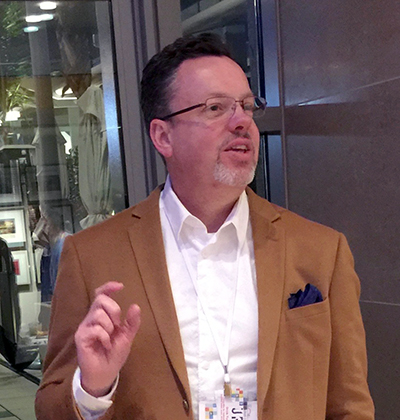
Erik Russell, Director of Programs at the Computing Research Association (CRA), is the 2019 winner of the AccessComputing Capacity Building Award. The award recognizes individuals whose work and accomplishments have changed the way the world views people with disabilities and their potential to succeed in challenging computing careers and activities. At the CRA, Erik primarily works in the development and management of programs that promote diversity and inclusion in the computing field. Since 2012, he has always made sure that disability was included in the conversation about diversity and inclusion at the CRA.
When the CRA’s Distributed Research Experiences for Undergraduates (DREU) program expanded to include other underrepresented groups besides women, Erik helped make sure that undergraduates with disabilities were eligible for the program and helped draft a memorandum of understanding with AccessComputing that allowed AccessComputing staff help in the matching process for undergraduates with disabilities and mentors. When the CRA started the new Graduate Cohort for Underrepresented Minorities and Persons with Disabilities (URMD), Erik helped to make sure that graduate students with disabilities were eligible for that program. Erik represents the CRA as an AccessComputing Organizational Partner.
We are thankful to Erik for his partnership over the years.
AccessComputing Co-PI and Partners Win 2019 SIGACCESS ASSETS Paper Impact Award
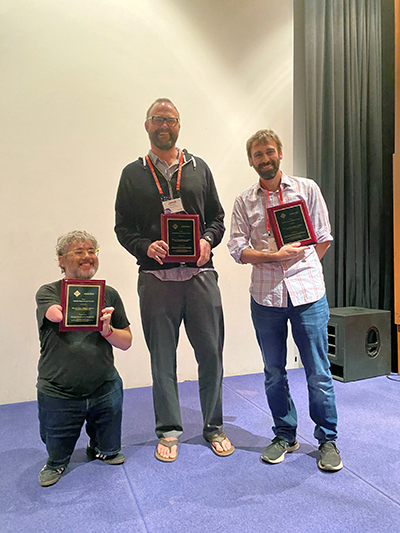
Every other year, the ACM Special Interest Group on Accessible Computing (SIGACCESS) awards a past paper from the ASSETS conference a prestigious lasting impact award. The chosen paper must be at least 10 years old and have made a demonstrable impact on research or practice in the field of accessible computing. This year, at ASSETS 2019, the award was given to a paper I authored with two AccessComputing partners: Shaun K. Kane of the University of Colorado, Boulder; Jeffrey P. Bigham of Carnegie Mellon University. Their paper from 2008 was entitled, “Slide Rule: Making mobile touch screens accessible to blind people using multi-touch interaction techniques.” Kane and Bigham were graduate students at the University of Washington when they did their work on Slide Rule.
The Slide Rule project was the first work to tackle the challenge of making touch screen devices accessible to blind people. Prior to 2007, I had conducted research on the accessibility of mobile devices, including mobile phones, that commonly employed tactile features such as raised buttons, dials, and knobs, which meant such devices could be operated, at least somewhat, by touch and hearing. But in 2007, with the advent of the Apple iPhone, all of the tactile landmarks went away. I was concerned that without these physical landmarks on phones, blind people or people who cannot see their devices would have no way to operate them. My then-Ph.D. student Shaun Kane and I took on the challenge to create the first finger-driven screen reader, which Kane built to intelligently read out text wherever a finger is touching the screen. If the finger moves faster, the text read-out is abbreviated. If the finger dwells on a location, the text is read fully. We also created a method by which a user could select targets on the screen without ever lifting the reading finger: upon hearing a target read aloud, such as a button label or hyperlink text, a second finger could tap anywhere on the screen and that target just read would be triggered. This technique has come to be known as a “split tap” gesture in today’s smartphone products. We also created gesture techniques for navigating lists and hierarchies, and transitioning between apps.
The success of Slide Rule was initially far from clear. “I talked to many other researchers about this idea,” said Kane. “Nobody thought it would work for users. They all told me it was bound to fail.” To compare Slide Rule to a de facto means of accessing a touch screen, Wobbrock recruited Jeffrey Bigham, then a Ph.D. student in computer science at the University of Washington and an expert on screen reader technology, to create a conventional screen reader as a comparison condition. “I thought for sure the conventional screen reader would win in our studies,” Bigham said. The team recruited blind participants to use both devices and perform tasks such as finding information, navigating among applications, and selecting targets. Slide Rule came out the clear winner, and users generally liked it as well. We were delighted and surprised by the result.
AccessComputing Co-PI Comes Out as Trans
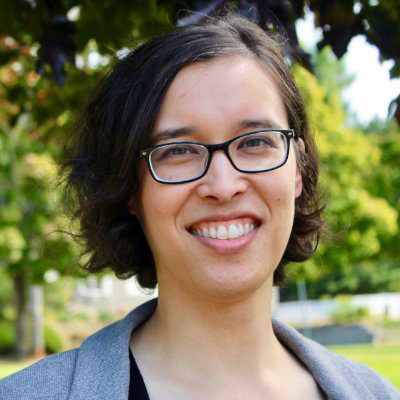
You may have noticed a new name among AccessComputing leadership. Amy Ko recently shared an insightful (and widely circulated) Medium post about being trans and deciding to come out. See the excerpt below and find the full post online.
It took me a lifetime, but I’ve recently accepted that I’m trans. Surprised? Read on for my story. But if you just want the key details, I identify as a woman, I prefer she/her/hers pronouns, and I’d like to be called Amy. If you cite my research, please use my new name Amy J. Ko, not Andrew J. Ko. While I’m increasingly secure in my gender identity, I’m pretty clueless about my gender expression, so expect some clumsy experimentation. Please refrain from policing my appearance or voice (or anybody’s for that matter). If you’d like to reach out to me, I’d most appreciate affirmations and expressions of support like, “Congratulations!”, “I’m here for you!”, and “You’re safe here!” but please no condolences like “That must be hard” or “I’m so sorry” — it is hard, but not having to hide my identity out of shame is a good thing. And if you’re trans yourself, especially in academia, please write me. I’d love to learn from your experiences, and help if I can. Thanks!
Also take a minute to read the NBC News profile of Amy, 'Call me Amy': Professor comes out as trans in viral letter. Amy continues to be a great leader within the AccessComputing community, and we value her expertise and perspective.
AccessComputing greatly values diversity and the LGBTQIA+ community, and we continue to put emphasis on intersectionality throughout our work.
Our Experiences as Speakers at the Grace Hopper Conference
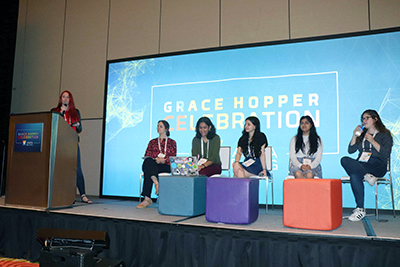
On October 1, 2019, more than 25,000 attendees gathered in Orlando, Florida for the Grace Hopper Celebration. As the world’s largest conference for women in computing, the five-day event hosted panels, mentoring sessions, an open-source codeathon, and talks on subjects ranging from technology trends to fostering diversity and inclusion in computer science. One such panel was “Navigating the Tech Scene With a Disability.” Moderated by Dr. Brianna Blaser from AccessComputing, the panel featured us, Meenakshi Das, a masters student at Auburn University, and Naba Rizvi, a senior at the University of Toledo; Lauren Siegel, a senior at North Carolina State University; and Rebecca Krieger, a program manager at Microsoft. The panelists discussed how to navigate disabilities in the context of education and employment. Women with disabilities are a double minority in computer science and often feel they do not fit into the technology scene. This panel attempted to foster discussions among not only women with disabilities but also provide advice to universities and companies on how they may better support people with disabilities.
The panel focused mainly on access and inclusion in education and the workplace. Some of the topics discussed included asking for accommodations in the workplace, disability disclosure, and how to change society’s perception of people with disabilities. One panelist shared her personal experiences with having others doubt her fluency in English due to her speech impairment. Another panelist recalled other people’s surprise in discovering she is a computer science major with a vision impairment. Mental health-related disabilities were also discussed and tips were shared on how to strategically approach these topics with employers and faculty.
Additionally, there was an open dialogue about making conferences such as the Grace Hopper Celebration more accessible. Examples of desirable accommodations at conferences included having live captioning and sign language interpretation available for deaf and hard-of-hearing attendees, placing signs and maps lower to make them more accessible for attendees in wheelchairs, and providing sighted guides for blind and low vision attendees. Guidance on how to approach interview accommodations like extra time, different modes of communication, and alternative methods of technical interviewing were also given.
The panel received excellent feedback from the audience, many of whom stayed back for further questions and networking with panelists. The importance of hosting similar events in the future to center the voices of people with disabilities in conversations regarding diversity and inclusion was emphasized by both the panelists and the audience. As stated by one of the panelists, Lauren Siegel, “it's not just about making a single event more accessible, it's about changing our society's attitudes toward people with disabilities.” Panels such as this are paving the way for a more inclusive society.
2019 Tapia Celebration of Diversity in Computing
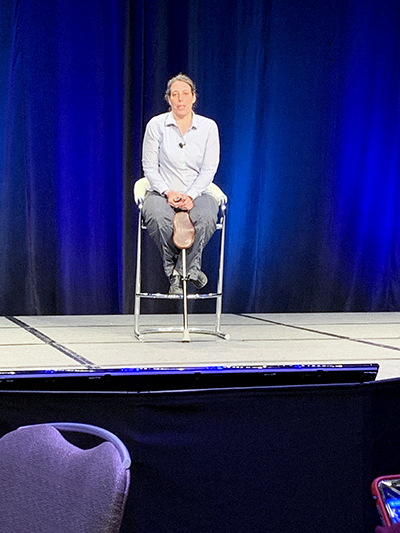
This September’s Tapia Celebration of Diversity in Computing, held in San Diego, CA, was the biggest Tapia Celebration yet and the first one to have an accessibility committee.
As chair of the accessibility committee, I was lucky to have a great group of committee members, including AccessComputing PI Richard Ladner, Jerri Barrett, Rua Williams, and Synge Tyson. We were able to increase accessibility and inclusion at the conference, which a specific focus on the following important items:
- Electronic versions of posters and presentations available online.
- An accessible PDF of the conference program
- A quiet room
- Increased training for student volunteers
- Information about conference accessibility on the website
It will be exciting to see how accessibility continues to improve at Tapia in future years.
We were also excited to provide travel funding for 11 AccessComputing team members to attend Tapia and see many other students at Tapia who had received travel funding from elsewhere. The conference kicked off with a keynote presentation from the University of Washington’s Jen Mankoff on “Making Accessibility,” and there were several other sessions on the conference program that focused on or addressed disability.
In early 2020, the call for proposals and travel scholarship application for Tapia 2020 will be available. When it is available, share this information with students and others in your community who may be interested in attending.
My Research Experience in Human-Computer Interaction
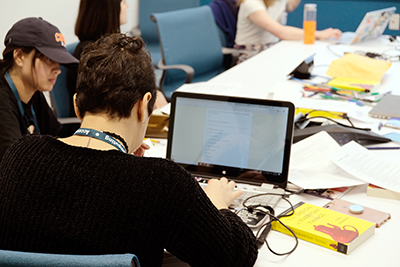
I am a senior Millennium scholarship recipient and an honors scholar majoring in computer science and mathematics at Troy University although I am originally from Alexandria, Egypt. I joined AccessComputing in 2018 and attended their OurCS@UW two-day research workshop in 2019. This community has really helped me integrate my learning and mental disabilities as part of my identity and empowered me to advocate for inclusivity in science, technology, engineering, and mathematics (STEM), as well as explore what I, as a researcher, can do to contribute to that. AccessComputing is also an instrumental player in my selection for The Teresa Haven Scholarship for Students with Disabilities.
This summer, I was given the opportunity to be a research assistant at the Human-Computer Interaction Lab at the University of Notre Dame (HCI@ND). HCI@ND is run by Dr. Ronald Metoyer, who has been my mentor and research advisor. Dr. Metoyer is also the assistant dean of diversity and special initiative at Notre Dame’s College Of Engineering. Our study was part of a broader project that is focusing on the process of holistic admissions and evaluation in undergraduate universities in the US. Admissions officers have to analyze the information in a growing volume of applications each year while maintaining objectivity and trying to take everything into context, which tends to be a tedious mental process. By analyzing the areas of improvement in the design of current digital applicant evaluation tools, our goal was to help them increase their efficiency in reviewing each applicant. As an intern, I worked with graduate students and met with my advisor daily. My tasks ranged from taking part in the planning process of participatory design activities to interviewing participants and analyzing qualitative and quantitative data.
I was introduced to the field of human-computer interaction as an accessibility and ubiquitous computing research intern for EvoXLabs back in 2017. EvoXLabs in an initiative that focuses on serving people with disabilities through technology and improving websites for people, particularly those with vision impairment. They also provide free accessible web solutions to non-profit organizations. I enjoyed applying my classroom knowledge of computer science to gain skills in algorithm design. I also discovered my knack for research as I studied people with color-blindness and how to create a Chrome-extension that would enhance their web-surfing experience. I have since avidly explored the field of HCI both by reading publications and having conversations with researchers in academia and industry. I like HCI because I can use my passion for technology to make a real-world impact towards a more equitable society and a better future.
I am thankful for this opportunity. Aside from the beautiful campus and the efforts of the research experiences for undergraduates (REU) administrative team to give us the best experience possible. They provided Brown Bag seminars to familiarize us with different areas of STEM, workshops on good practices in research and graduate school degree-types and application processes, and social and professional networking activities. I know I walked away this summer with a repertoire of valuable skills, including how to effectively interview participants and how to complete data analysis. I not only learned about holistic admissions, but also the field of information visualization. I have explored valuable technical skills like visualizing data through d3.js. Finally, I honed my presentation and communication skills as I presented our project in the annual undergraduate research symposium. Dr. Metoyer and our team are still working on a conference proceeding.
If I had to give advice to other students with disabilities in STEM out there, it would be to be involved in their communities, to participate in diversity initiatives actively, and to explore and advocate for their beliefs. I know I would not have such a positive college experience as an international student in the US if it was not for my involvement and volunteering in multiple diversity in STEM initiatives, such as AccessComputing, the Grace Hopper Celebration, the AnitaB.org Systers online community, URGE, NSBE, CRA-WP, ACM-W, Lesbians Who Tech, ELPHA, Hexagon UX, NextBillion, Cornell SoNIC, and GeorigaTech’s FOCUS. I also took the initiative to manage the first hackathon in the southern part of Alabama as the president of Troy University’s Computer Science Club in the past year. My team was driven by their dream to bring educational and professional opportunities to the untapped talent in the area as well as to promote the participation of underrepresented minorities in computing.
I am very grateful for this experience and the opportunity to not only grow my resume, but learn important skills and make lifelong connections. I had an amazing and inspirational advisor who was very hands-on and made sure that I learned as much as I can during my time in his lab. I was part of a dynamic and energetic team of researchers, and I know that I am not only more prepared for graduate school but also a career in research beyond. I am currently applying for Ph.D. programs in Computer Science as well as preparing for a semester-long study abroad program at the University of Skövde in Sweden.
DO-IT's Newest Program, AccessISL
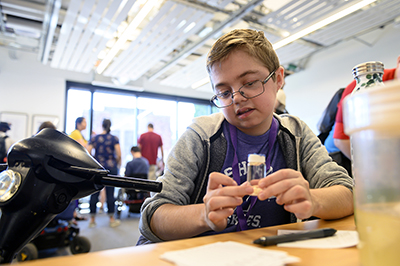
The University of Washington’s (UW) DO-IT Center and Museology Program are collaborating on a newly funded two-year Access to Informal STEM Learning for Participants with Disabilities (AccessISL) project. It is funded by the National Science Foundation Advancing Informal STEM Learning (AISL) Pilots and Feasibility Studies program (Grant #DRL-1906147). The grant will support efforts to develop a capacity building model for making informal science learning (ISL) opportunities more welcoming and accessible to individuals with disabilities.
DO-IT Director Sheryl Burgstahler said “We are excited about the potential AccessISL has to increase opportunities for people with disabilities to learn about science through museums, science centers, and other informal science programs.”
The project will help faculty and ISL personnel increase knowledge, skills, and actions to make ISL programs, facilities, courses, and resources more welcoming and accessible to participants with disabilities and embed relevant practices within their work. The project will also engage postsecondary STEM students with disabilities and museology students and increase knowledge and skills in advocating for ISL offerings that are welcoming and accessible to everyone, including those with a wide variety of disabilities, as well as encourage individuals with disabilities to pursue careers in ISL.
Dr. Meena Selvakumar states “The Museology Program is excited to integrate learnings and practices from the AccessISL project into our pedagogy. We believe this will have a positive impact on our emerging museum professionals as they go on to be agents of change in the field.”
Staff of informal science education programs, educators, and other stakeholders are invited to join the AISL Community of Practice (CoP). The CoP provides opportunities for participants associated with ISL programs to share best practices, form collaborations, and highlight project activities. Learn more online.
Resources from AccessCyberlearning
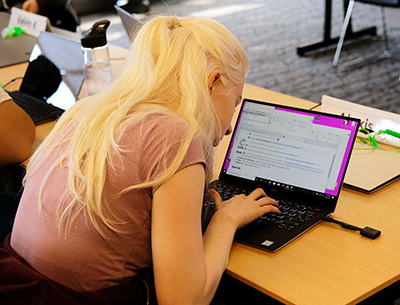
In 2018, DO-IT submitted a proposal to the National Science Foundation and received funding for a one-year grant focused on conducting exploratory research to inform the design of the next generation of digital learning environments for science, technology, engineering, and mathematics (STEM) content. Since the beginning of the year, the team successfully held a 2.5-day capacity building institute (CBI) with other cyberlearning colleagues from around the country, engaged in an online community of practice, and completed four significant documents that promote the design of cyberlearning opportunities that are accessible to students and instructors with disabilities:
- Proceedings from the AccessCyberlearning 2.0 Capacity Building Institute
- An 11-page white paper: Accessible Cyberlearning: A Community Report of the Current State and Recommendations for the Future
- A short brochure with direct recommendations for designing and implementing accessible online learning: Guidelines for Cyberlearning Researchers
- A comprehensive document that goes deeper into the research being done and different needs, the roles of various stakeholders, and more: Designing Accessible Cyberlearning: Current State and Pathway Forward
AccessComputing Shares Commitments at CSforAll Summit
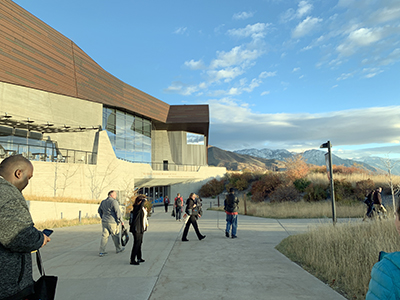
Through our involvement with the CSforAll Consortium, we have made several commitments related to computer science education. CSforALL commitments are new, specific, and measurable actions taken by community stakeholders in support of achieving the ultimate goal of computer science for all US students. As part of the 2019 CSforAll Summit, hundreds of organizations announced new commitments to computer science education.
2019 commitments from AccessCSforAll and AccessComputing include the following:
- AccessCSforAll will provide professional development for teaching an accessible version of Computer Science Principles to at least 15 teachers who have expertise in teaching students who are learning disabled by Fall 2020.
- Quorum will release and promote Quorum Studio, a fully accessible IDE (integrated development environment).
- AccessComputing will recruit and support high school students with disabilities at 200 schools that serve students who are blind, deaf, or have learning disabilities in order to assist them in transitioning to college in computing fields.
At the Summit, AccessComputing staff Brianna Blaser spoke on a panel about our efforts as part of a session titled Defying the Status Quo: Systems Approaches to Inclusion. During the session, speakers gave lightning talks about their commitments and how they encompass a systems approach to ensure inclusion of students from the unique population they serve in rigorous computer science. Discussion focused on system-change approaches to inclusion for students from native populations, students of color, students with disabilities, and students who are language learners.
My Research on Amblyopia and in Accessibility
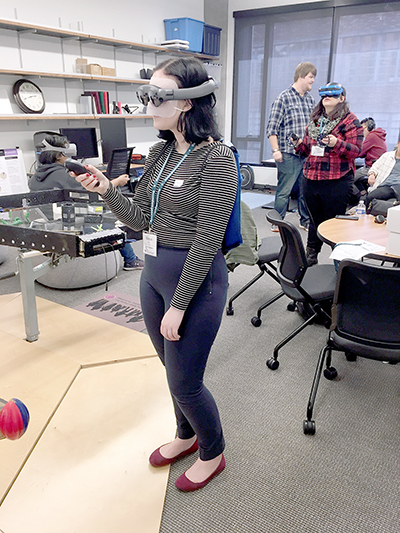
I had already had ideas for a project around amblyopia—sometimes known as lazy eye—when I was working on a few other projects under Ph.D. students of Professor Mircea Teodurescu, who is married to Sri Kurniawan, the leader of the Assistive Sociotechnical Solutions for Individuals with Special needs using Technology (ASSIST) Lab. Professor Teodurescu gave me a lab tour and invited me to attend his next lab meeting. After a few months on the PhD students’ projects, I told Mircea I was interested in using the lab’s virtual reality for this amblyopia project I had thought of and wanted to test. He introduced me to Professor Kurniawan, and she expressed interest in the project idea and agreed to fund me to research for them. At this time I was also already the leader for ALI (Accessibility Leadership and Internship), a group funded by the disability resource center on campus to destigmatize disability, so I loved the research I was doing and how I could make a difference for students with visual impairments in STEM. I have been happily working for Sri’s lab, ASSIST Lab ever since.
The project I started working on came from my own experiences as a person with amblyopia. Amblyopia, though very serious, impacting everything from vision to reading comprehension, is treatable via occlusion therapy. Its effectiveness has been known for decades. However, compliance with occlusion therapy is infamously bad. Due to this, there has been a slew of new research looking into using 3D or virtual reality video games as therapy, with probably the most famous project being Vivid Vision. These research projects have been largely successful and offer a wonderful alternative to traditional treatment.
However, some of these projects, surprisingly, did not report great compliance with therapy. I was shocked when I first learned this. I was one of those people with amblyopia who was prescribed to do occlusion therapy and did not follow through with it—therapy was often very uncomfortable. As someone who also loves virtual reality, I started wondering why these projects did not have better compliance than traditional therapy; personally, I would love to play virtual reality games as my therapy. I started taking a look at some of the game designs that were being used and thought some of them might be problematic, considering the symptoms of amblyopia. I wanted to see if other people with amblyopia agreed with my analysis. I used Unity to create a VR video game like those being used in the most cutting-edge research and I invited participants to play it with an HTC Vive.
I then interviewed participants. I asked them questions about the game design and projected compliance and found some recurring themes. I found that keeping visual crowding to a minimum is more comfortable. Visual crowding is when there are too many objects in one’s field of view, and it bottlenecks object recognition. The visual crowding phenomenon is something people with amblyopia have a hard time with, so it makes sense that this was a re-occurring theme. Additionally, participants reported that having the key objects be large, “about the size of a small dinner plate,” and visually distinct was more comfortable. Furthermore, having haptic and audio feedback for confirmation of touch is beneficial. People with amblyopia have a loss of depth perception, making it critical to acknowledge in the game design process. An even better solution would be to use accessibility researcher Yuhang Zhao’s Unity asset for game designers to add to their games to make them more accessible to people with visual impairments. This asset has a setting that allows game developers to add a beam that comes out of the controller and onto an object to better understand the depth. Additionally, we found having a game that requires movement left to right, but not as much forwards and backward, is more comfortable. Left and right movement relies less on depth perception. Lastly, people with amblyopia have a difficult time reading. Thus, it makes sense our participants were in favor of play through instructions instead of text-based instructions. Additionally, participants did not like timed reading expectations in video games. For example, text that quickly pops up to tell you “slash as many as possible” and promptly disappears. Hopefully, if 3D and VR games take these insights into account while designing their game, they are likely to have an increase in compliance and, therefore, overall efficacy.
Throughout my research and education, my disabilities have made my working process slower than that of other people in my major. It can be extremely frustrating, but I’ve learned that it is okay, and that I should be proud of what I can do. Additionally, as a symptom of one of my disabilities, I can have very rigid ideas of concepts and get stuck when it does not fit my rigid understanding. Since my disabilities are all invisible, many people do not understand when I get so stuck on certain concepts or ideas in computer engineering. There were many times in the past where I considered changing majors and felt I did not belong in this major. However, working closely with disability activists at ALI has opened my eyes to the value of communication, humility, and finding ways to make things work for me.
I have done a lot of work in accessibility. I used to work for Professor Azenkot at Cornell Tech, where I was doing accessibility research and writing academic papers on the subject. I was encouraged to submit a paper to the Student Research Competition, which was accepted. I got to showcase my poster to judges, and even made it to the semi-finals. I was extremely nervous, but it was a great opportunity, and I expected from there, that it was generally over. However, at the reception that night, I was shocked to receive first place—I had been extremely impressed with both projects that came in second and third. I was so full of adrenaline that I do not even remember physically walking up to the stage at the front of the theater. The entire experience was absolutely amazing and is my most fond memory from my career in research. ASSETs is not just a conference but a community of the most compassionate, motivated, and accepting people.
I was also fortunate enough to attend the Grace Hopper conference this year, where I was able to secure a job at Bank of America in accessibility. I was told that I will be working on making ATMs more accessible for people with disabilities as well as create software to make Bank of America a more comfortable place for employees with disabilities to work.
Professional Development for Teachers of Deaf and Hard of Hearing Students
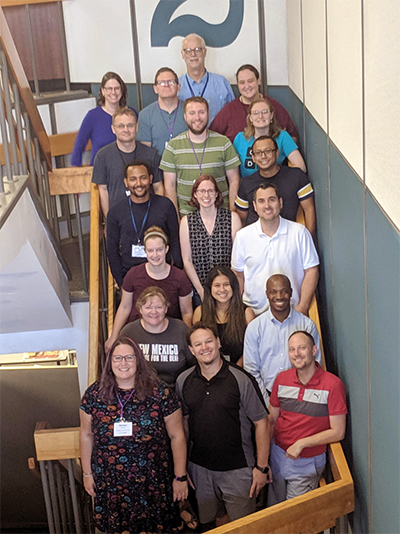
In summer 2019, our companion project AccessCSforAll held a professional development workshop for high school teachers of deaf and hard of hearing students at the Model Secondary School for the Deaf (MSSD) in Washington, D.C. The focus of the workshop was on helping the teachers incorporate computer science, and in particular, the AP Computer Science Principles (CSP) course, into their schools’ curriculum. The workshop was led by me and Andreas Stefik with assistance from Jill Naumann, who had been teaching AP CSP for several years at MSSD, and Erin Peach, who is a developer at Code.org.
Fourteen teachers participated in the workshop from 11 different states. The workshop was given in American Sign Language (ASL) with the help of two ASL interpreters because one staff and eight participants were themselves deaf. A major part of the workshop was devoted to the participant pairs preparing and presenting AP CSP lessons with the other participants acting as students. All the lessons were given in ASL stressing the bilingual approach to education practiced by all the participants in their schools. In this way the participants learned from each other effective teaching pedagogy suitable for their deaf and hard of hearing students, in addition to learning computer science content.
A paper about the workshop will be presented at the RESPECT (Research in Equity and Sustained Participation in Engineering, Computing, and Technology) Conference in Portland, OR in March.
2019 Resume Activity
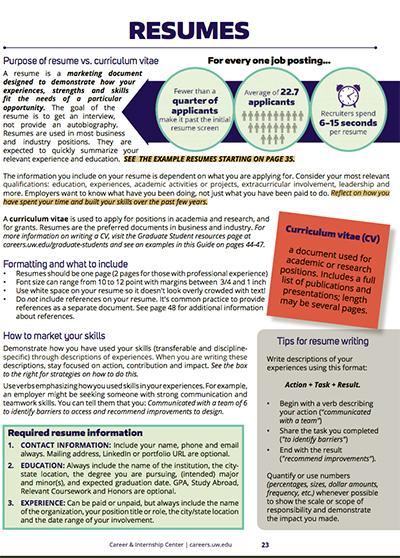
The school year may have just begun, but if you are applying for summer internships, now is the perfect time to update and edit your resume to make sure you have the best application possible.
Every year AccessComputing and AccessSTEM participants get the chance to engage with staff and get feedback on their resumes through our annual resume contest. We look at formatting, grammar, content, and how well the resume reflected the student’s success. Below are some common themes and questions that came up as we looked over the submissions.
Should I include social media?
This is a big change in resume practices: including professional social media links. This is something you need to pay attention to, because being intentional about what you include is imperative to showcasing not only your additional projects and information relating to your academic work, but also your personality. You may choose to include your LinkedIn profile, an online portfolio, or your GitHub link.
How do I get past the “bots”?
The first hurdle in getting your resume in front of employers is getting through resume scanning software that helps determine whether a certain applicant is qualified for the job. If your resume doesn’t have enough keywords or phrases that match the job description it may be automatically removed from the pool. Scatter some keywords throughout your resume that are directly from the job description. To do this, consider including a skills section. This could consist of programming languages, software, or other specific skills you wish to highlight. Pay special attention to the skills directly related to the job to which you are applying. Many articles online recommend sending employers Word documents so that your resume can be scanned properly, although most scanners can now read PDFs.
How do I make my resume easier to read?
Some resumes simply have too much content. Make your resume concise by limiting each job’s duties to three or four bullets, cutting irrelevant positions, and making use of white space.
Is my resume too short/ too long?
The length of your resume is important to consider. It looks more professional to have a resume one full page or two full pages rather than including partial pages. All the information you include should have a purpose, not merely “fluff” to make it longer. If you include an objective statement make it as specific as possible and think about whether an objective statement could be included it in a cover letter instead.
The resume submissions reinforced the amazing academic achievements and skills of the AccessComputing and AccessSTEM team members. Whether it was highlighting their GPAs, internships, scholarships, and publications, or how they’ve entered their careers, we are proud of everyone’s accomplishments.
DO-IT staff are always available to help students revise their resumes and give feedback. University career centers are also a good resource to go to for in-person help.
Our Trip to Microsoft
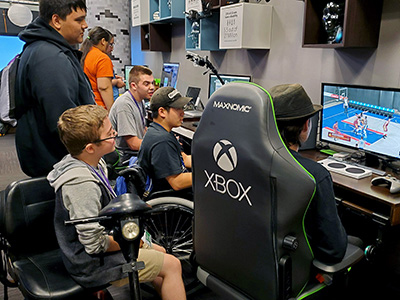
On the first Friday of the DO-IT Scholars Summer Study, we took a trip to the Microsoft campus and participated in some engaging activities. First, DO-IT Scholars split into small groups to design a robotic dog that could aid people with disabilities. One common idea was that the dog could detect objects and sounds nearby and notify its owner in various ways. This activity simulated how an innovative company like Microsoft creates and designs new products.
After that, we had a presentation about Microsoft and how its products have accessibility tools to help people with disabilities. Next, we listened and asked questions to a panel with Microsoft employees who have a disability. A few of them have been a part of the DO-IT program. They discussed what designers, engineers, and program managers do as a team and explained their journeys and struggles and how Microsoft has helped them continue their work.
For lunch, Microsoft provided us with a taco bar, which was really nice. We were treated like employees for the day and had many drink options available. It is definitely a great perk of working at Microsoft.
After lunch, our group headed across campus to the Xbox Inclusive Tech Lab. The goal of the lab is to make sure everyone can play games. We learned and talked about the Xbox Adaptive Controller, which is for people who have difficulty playing with a normal controller. Bryce, who works at the lab, showed us some videos of people using the Xbox Adaptive Controller to show how it can help someone with a disability that makes it hard to hold a regular game controller. A regular Xbox controller can pair up with one of the adaptive controllers to work as one whole controller. The adaptive controller also can connect to many different customizable switches. We listened to a 3D surround sound system, which helps people who are deaf or hard of hearing. It brings a whole new level to movies, TV, and music. After the presentation, everyone was allowed to play video games on Xbox consoles and PCs using many types of controllers. We chose to play Minecraft on the PC, which was fun. Other Scholars chose to play different games, such as soccer and other sports. We had a great experience at Microsoft.
About AccessComputing
Led by the Paul G. Allen School of Computer Science & Engineering, the Information School, and DO-IT (Disabilities, Opportunities, Internetworking, and Technology) at UW, AccessComputing is supported by the National Science Foundation (NSF) (Grant #CNS-0540615, CNS-0837508, CNS-1042260, CNS-1539179). Any opinions, findings, and conclusions or recommendations expressed in this material are those of the authors and do not necessarily reflect the views of the NSF. For further information, to be placed on the mailing list, request materials in an alternate format, or to make suggestions for project publications or web pages, contact us:
AccessComputing
University of Washington
Box 354842
Seattle, WA 98195-4842
accesscomp@uw.edu
www.uw.edu/accesscomputing/
206-685-DOIT (3648) (voice/TTY)
888-972-DOIT (3648) (toll free voice/TTY)
206-221-4171 (FAX)
Richard Ladner, PI
Sheryl Burgstahler, Co-PI
Amy J. Ko, Co-PI
Jacob O. Wobbrock, Co-PI
Brianna Blaser, Project Coordinator
Kayla Brown, Project Coordinator
Lyla Crawford, Internal Evaluator